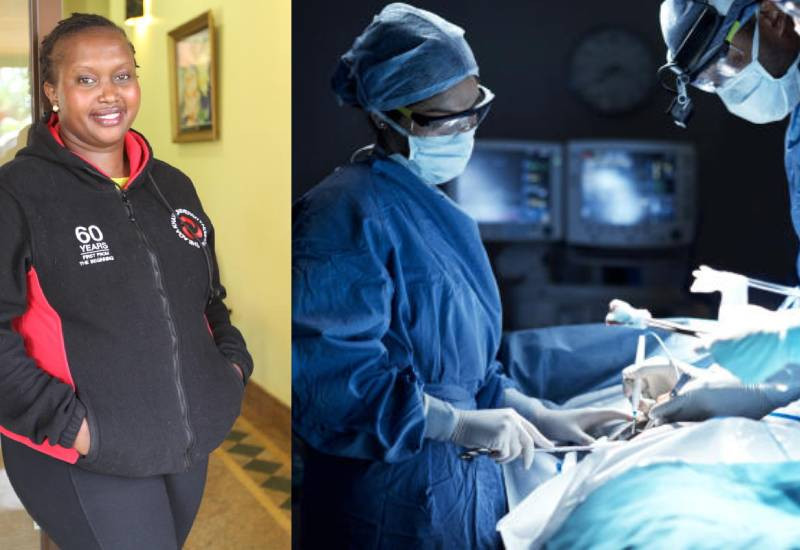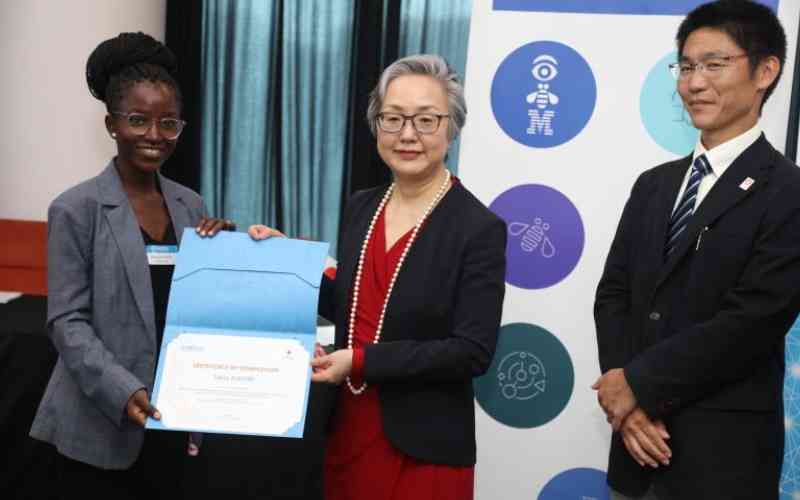
The first time Asunta Wagura, 51, decided to go against all odds and conceive was 2006. She was scorned and encouraged almost in equal measure because of her HIV status. She was also 41 years old, an age many considered too old for childbirth.
The encouragement was mostly from women like her, whom she euphemistically referred to as TTC; trying to conceive. The criticism was from people who did not understand why a public figure, the Executive Director of the Kenya Network of Women with Aids (Kenwa), and a mother of one who had lived with HIV for about 20 years wanted another baby.
The birth of Asunta's son, Joshua in 2006 became something of a public spectacle. But not many people knew about the deeply private and personal demons that Asunta battled. She had a miscarriage and near-miscarriage, both kept under wraps, and the last one almost robbed her of this dream that she had carried for years.
At the suggestion of her partner Richard they decided to play this close to their chests. They did not want to jinx their chances of a great outcome by going public. But there is no harder burden than trying to keep a pregnancy a secret. Especially if you are a public figure of Asunta's stature and you have back-to-back assignments, locally and abroad.
"After giving birth to Joshua, I promised myself that I would conceive after six months, hoping to get a baby girl," Asunta said at the time. "I'm just a sucker for girls. The doctor at the discharge ward had warned me that since my case was a Caesarian, I should not consider getting pregnant again."
Another maternal urge, another baby
But it was not until 2010 that maternal urges got the better of Asunta. She gave birth to another son, Israel Munene. But she kept this third bite at the conception cherry away from the public.
Asunta's eldest son, Peter Kanyi, 26, was born in 1990, during a time when medical measures like prevention-of-mother-to-child transmission of HIV were virtually non-existent. Years later, Peter tested HIV negative.
"I consider Peter's HIV negative status an act of mercy from God. He spared me the worries, anguish and stresses ... I would have worried myself literally to death. I would have blamed myself for his predicament."
But if Peter's birth was not without any medical hassle, it was not the same with Israel's. Things just did not go as planned. Even with assisted reproductive technology (ART), there is always a margin of error, and the doctors cross the bridges as they come to them. Asunta's follicle-stimulating hormone (FSH) – which helps to control the menstrual cycle and the production of eggs in the ovaries – was high, and her fertility doctor gave her the all clear.
The "trade-off" for this baby was enduring the adverse side-effects of antiretroviral drugs. Asunta lost her figure due to lipodystrophy; a life-long side effect of the other antiretroviral drugs that she had been using. Lipodystrophy is the abnormal distribution of fat in the body.
To alleviate Asunta's concerns, the doctor assured her that the drugs were friendly to the life they were creating her womb.
"I think that such adverse side effects and the relative uncertainty of the outcome is what puts off many women who are living with HIV, and who are above the age of 40, from TTC," Asunta says.
There is also the fact that some men are not so willing to go with their partners to ART clinics. It takes two to tango. Asunta had to constantly drag Richard along for clinic visits. And there is also the fact that the cost of ART is prohibitive, and sometimes the costs may rise exponentially. Patience may, progressively, wear thin – with each trial and error.
"Once again, I was criticised for being too selfish that I wanted another baby yet I had others ... and on top of that, I have HIV," Asunta said at the time. "By joining other sisters above 40 years who had fertility issues and were pulling out all the stops to conceive, I did the right thing at the right time. There were younger women, and others who were older, but we were all facing a common enemy. The online facility, Network 54 helped me to rationally look at my issues and realise that I wasn't doing badly. Others sisters encouraged me."
"It mattered a lot to those who were walking in the same shoes as me. I felt awesomely younger because one of the ladies in our group was 59 years old. She had been denied assisted ART in her country and she had sourced for this service in a foreign land. She was eight months pregnant and it was like any other pregnancy. So, those who are saying I'm old, think again. I can do this. Again."
What almost sunk Asunta into a depression was Israel's diagnosis with autism spectrum disorder (ASD) in 2012.
"At first, I was in denial. I blamed myself. I thought it was something I had done, which had caused this condition. I thought it was something to do with my age or my HIV-status, but the doctor put my worries and self-blame to rest."
Double blessings
And in 2013 at the age of 48, Asunta did it again. She was blessed with identical twin boys, Gabriel and Baraka.
"I felt like my biological clock was ticking faster than ever before, and, sooner than later, if I did not conceive, I might run out of time. As you know, time is not on my side so I decided to get pregnant for one last time. This was the last time. In fact, these babies are my retirement plan."
Asunta's doctor was surprised when she dropped this baby bombshell. But the doctor prepared her for this last hurrah, and made sure that her health and that of her unborn babies would not be in jeopardy.
"For starters, my viral load was undetectable, which gave me the green light. An undetectable viral load means the amount of a virus in a person's blood is lower than can be measured by the test. However, it does not mean that there is no HIV in the person's body."
Still, the pregnancy had hiccups, which necessitated a change of ARVs. Asunta's health was adversely affected, and her CD4 count tanked from a high of 680 to a low of about 400.
And when the time came to give birth, she developed unforeseen health complications. The doctors could not get measure her blood pressure, and it was their preparedness and quick action that saved her babies.
Anxious moments
"Women who are seeking ART services should be aware that there is a difference between gynaecologists who offer the fertility drug Clomid, and ART practitioners who offer their clients technical assistance," Asunta says.
"With prescriptions like Clomid, which is often the first time therapy for infertility, you can become pregnant quickly, but ART can take more than 14 months of trial and error, and waiting."
A woman needs to know what she is signing up for, so you should always consult your doctor when you are unsure, or if you feel like you are being taken for a ride. After all, it is your time, money and, ultimately, baby. And do not be afraid of going for a second opinion, although this too will cost you a pretty penny.
And even when one has followed all the instructions, emergencies may happen at the most importune times.
For Asunta, the anxious moment came on the day that she was being wheeled into the delivery room, just when she thought that the anxieties were behind her. While doing last-minute checkups, the nurse informed the mother-to-be that she could not feel the second heartbeat.
"I almost lost it. I was panicking and screaming, and shouting at the nurse to find the heartbeat at any cost. I thought about all those months I had sacrificed with money and my body, and now this. Fortunately, they found the missing heartbeat." See is now the proud mother of two, beautiful twin boys, bring her brood to a total of five, each one of them a miracle.
The ART gap
Asunta says that, locally, ART practitioners are few. During specific months of the year, foreign practitioners set up base here and charge an arm and a leg for their services.
"It can be confusing for a new patient who is unfamiliar with medical terminologies, which is why it is best for one to research on the Internet and at least have some basic knowledge of what they are really getting into."
The most commonly known form of ART is in-vitro fertilisation (IVF). In this procedure, fertilisation is done externally, and the best embryos are transferred into the uterus after a stipulated amount of time.
Other forms of ART are surrogacy, embryo donation and egg donation. Each of these comes with its own share of complications.
 The Standard Group Plc is a multi-media organization with investments in media platforms spanning newspaper print
operations, television, radio broadcasting, digital and online services. The Standard Group is recognized as a
leading multi-media house in Kenya with a key influence in matters of national and international interest.
The Standard Group Plc is a multi-media organization with investments in media platforms spanning newspaper print
operations, television, radio broadcasting, digital and online services. The Standard Group is recognized as a
leading multi-media house in Kenya with a key influence in matters of national and international interest.










